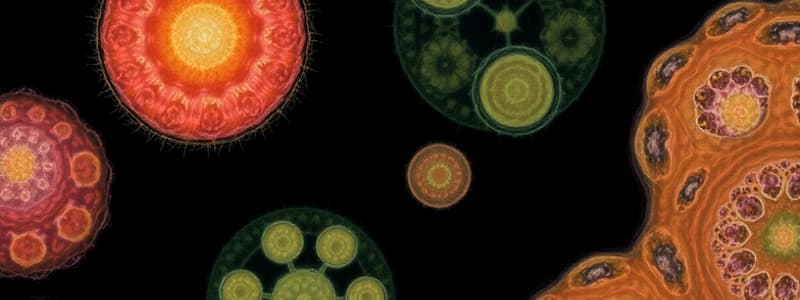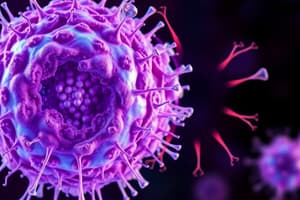Podcast
Questions and Answers
Which of the following cellular components is NOT directly involved in protein synthesis?
Which of the following cellular components is NOT directly involved in protein synthesis?
- mRNA
- Endoplasmic reticulum
- Golgi apparatus (correct)
- Ribosomes
A scientist is studying a cell and observes that it contains a nucleus and several membrane-bound organelles. Based on this information, the cell is most likely:
A scientist is studying a cell and observes that it contains a nucleus and several membrane-bound organelles. Based on this information, the cell is most likely:
- Lacking genetic material
- A eukaryotic cell from the domain Eukarya (correct)
- A prokaryotic cell from the domain Bacteria
- A prokaryotic cell from the domain Archaea
In a particular species of flowering plant, the allele for red flowers (R) is dominant over the allele for white flowers (r). If a heterozygous plant (Rr) is crossed with a homozygous recessive plant (rr), what is the probability that the offspring will have white flowers?
In a particular species of flowering plant, the allele for red flowers (R) is dominant over the allele for white flowers (r). If a heterozygous plant (Rr) is crossed with a homozygous recessive plant (rr), what is the probability that the offspring will have white flowers?
- 75%
- 50% (correct)
- 0%
- 25%
Which of the following is an example of gene flow?
Which of the following is an example of gene flow?
Which of the following best describes the process of allopatric speciation?
Which of the following best describes the process of allopatric speciation?
In an ecosystem, which of the following organisms would be considered a primary producer?
In an ecosystem, which of the following organisms would be considered a primary producer?
Which of the following describes a symbiotic relationship where one species benefits and the other is harmed?
Which of the following describes a symbiotic relationship where one species benefits and the other is harmed?
Which of the following processes involves the synthesis of RNA from a DNA template?
Which of the following processes involves the synthesis of RNA from a DNA template?
A population of birds lives on an island. Over time, a new volcano erupts, splitting the island in two. The two bird populations can no longer interbreed. This is an example of:
A population of birds lives on an island. Over time, a new volcano erupts, splitting the island in two. The two bird populations can no longer interbreed. This is an example of:
Which of the following factors is NOT typically considered an abiotic factor influencing an ecosystem?
Which of the following factors is NOT typically considered an abiotic factor influencing an ecosystem?
Flashcards
Cell Theory
Cell Theory
States that all living things are composed of cells, the basic unit of life, and cells come from pre-existing cells.
Eukaryotic Cells
Eukaryotic Cells
Cells with a nucleus and membrane-bound organelles.
Plasma Membrane
Plasma Membrane
Selectively permeable barrier that regulates the passage of substances into and out of the cell.
Mitosis
Mitosis
Signup and view all the flashcards
Genetics
Genetics
Signup and view all the flashcards
Gene
Gene
Signup and view all the flashcards
Phenotype
Phenotype
Signup and view all the flashcards
Law of Segregation
Law of Segregation
Signup and view all the flashcards
Evolution
Evolution
Signup and view all the flashcards
Ecology
Ecology
Signup and view all the flashcards
Study Notes
- Biology is the scientific study of life, examining the structure, function, growth, origin, evolution, and distribution of living organisms
Cell Biology
- The cell theory states that all living organisms are composed of one or more cells
- The cell is the basic unit of structure and organization in organisms
- Cells arise from pre-existing cells
- Cells are broadly classified into prokaryotic and eukaryotic cells
- Prokaryotic cells lack a nucleus and other membrane-bound organelles
- Bacteria and Archaea are prokaryotes
- Eukaryotic cells have a nucleus and other membrane-bound organelles, like mitochondria and endoplasmic reticulum
- Eukarya includes protists, fungi, plants, and animals
- Key cellular structures include the plasma membrane, cytoplasm, and genetic material (DNA)
- The plasma membrane is a selectively permeable barrier regulating substance passage into and out of the cell
- The cytoplasm is a gel-like substance within the cell containing organelles and cytosol
- DNA carries the cell's genetic information, organized into chromosomes in eukaryotes
- Organelles perform specific functions within the cell
- Mitochondria produce ATP through cellular respiration
- Ribosomes are responsible for protein synthesis
- Endoplasmic reticulum (ER) is involved in protein and lipid synthesis
- The Golgi apparatus modifies, sorts, and packages proteins
- Lysosomes contain enzymes for intracellular digestion
- The cytoskeleton provides structural support and facilitates cell movement
- Centrioles (in animal cells) are involved in cell division
- Cell division occurs through mitosis (for growth and repair) and meiosis (for sexual reproduction)
- Mitosis results in two identical daughter cells
- Meiosis results in four genetically different haploid cells
Genetics
- Genetics is the study of heredity and variation of inherited characteristics
- Gregor Mendel is considered the father of genetics; he discovered basic inheritance principles via pea plant experiments
- Genes are the units of heredity, composed of DNA sequences
- Alleles are different forms of a gene
- Genotype refers to an organism's genetic makeup
- Phenotype refers to the observable characteristics
- Homozygous individuals have two identical alleles for a gene
- Heterozygous individuals have two different alleles
- Dominant alleles mask the expression of recessive alleles in heterozygous individuals
- Mendel's law of segregation states that allele pairs separate during gamete formation
- Mendel's law of independent assortment states that genes for different traits are inherited independently
- Chromosomes consist of DNA and proteins; genes are located on chromosomes
- DNA is a double-stranded helix of nucleotides
- Nucleotides consist of a sugar, phosphate group, and nitrogenous base
- The nitrogenous bases in DNA are adenine (A), guanine (G), cytosine (C), and thymine (T)
- RNA is a single-stranded nucleic acid that plays a role in protein synthesis
- RNA contains uracil (U) instead of thymine (T)
- DNA replication is the process by which DNA is copied
- Transcription is the process by which RNA is synthesized from DNA
- Translation is the process by which proteins are synthesized from RNA
- The genetic code is the set of rules by which information encoded in genetic material (DNA or RNA) is translated into proteins
- Mutations are changes in the DNA sequence
- Mutations can be spontaneous or induced by mutagens
- Gene expression is the process by which the information encoded in a gene is used to synthesize a functional gene product (protein or RNA)
- Biotechnology involves the use of living organisms or biological systems to develop or make products
- Genetic engineering involves the manipulation of genes to alter the characteristics of an organism
Evolutionary Biology
- Evolution is the change in the heritable characteristics of biological populations over successive generations
- Charles Darwin proposed the theory of evolution by natural selection
- Natural selection is the process by which individuals with advantageous traits are more likely to survive and reproduce
- Adaptation is the process by which organisms become better suited to their environment
- Fitness refers to the ability of an organism to survive and reproduce
- Evidence for evolution comes from fossils, comparative anatomy, embryology, and molecular biology
- Homologous structures are structures in different species that have a common ancestry
- Analogous structures are structures in different species that have similar function but different ancestry
- Vestigial structures are structures in organisms that have lost their original function
- The fossil record provides evidence of the history of life on Earth
- Biogeography is the study of the distribution of species and ecosystems in geographic space and through geological time
- Microevolution refers to changes in allele frequencies within a population
- Macroevolution refers to the evolution of new species and higher taxonomic groups
- Mechanisms of microevolution include mutation, gene flow, genetic drift, and natural selection
- Gene flow is the transfer of genetic variation from one population to another
- Genetic drift is the change in allele frequencies due to chance events
- Speciation is the process by which new species arise
- Allopatric speciation occurs when populations are separated by a geographic barrier
- Sympatric speciation occurs when populations diverge without geographic isolation
- Phylogeny is the study of the evolutionary relationships among organisms
- Phylogenetic trees are diagrams that depict these relationships
- The biological species concept defines a species as a group of organisms that can interbreed and produce fertile offspring
- Mass extinctions are events in which a large percentage of species go extinct in a relatively short period of time
Ecology
- Ecology is the study of the interactions between organisms and their environment
- An ecosystem consists of all the living organisms (biotic factors) and non-living components (abiotic factors) in a particular area
- Abiotic factors include sunlight, temperature, water, nutrients, and soil
- Biotic factors include interactions among organisms, such as competition, predation, and symbiosis
- A population is a group of individuals of the same species living in the same area
- A community is a group of interacting populations of different species
- The biosphere is the global sum of all ecosystems; it is the zone of life on Earth
- Energy flow in ecosystems begins with primary producers (autotrophs) that convert sunlight into chemical energy through photosynthesis
- Consumers (heterotrophs) obtain energy by feeding on other organisms
- Food chains and food webs describe the flow of energy through ecosystems
- Trophic levels represent the different feeding levels in a food chain or food web
- Ecological pyramids illustrate the relative amounts of energy, biomass, or numbers of organisms at each trophic level
- Nutrient cycles describe the movement of essential elements through ecosystems
- Key nutrient cycles include the water cycle, carbon cycle, nitrogen cycle, and phosphorus cycle
- Competition occurs when organisms compete for the same resources
- Predation occurs when one organism (the predator) feeds on another organism (the prey)
- Symbiosis is a close and long-term interaction between two different species
- Mutualism is a symbiotic relationship in which both species benefit
- Commensalism is a symbiotic relationship in which one species benefits and the other is neither harmed nor helped
- Parasitism is a symbiotic relationship in which one species benefits and the other is harmed
- Population growth is influenced by birth rates, death rates, immigration, and emigration
- Carrying capacity is the maximum population size that an environment can support
- Community structure is influenced by factors such as species diversity, keystone species, and disturbance
- Ecological succession is the process of change in the species structure of an ecological community over time
- Conservation biology is the study of protecting and managing Earth's biodiversity
- Threats to biodiversity include habitat loss, invasive species, pollution, climate change, and overexploitation
Studying That Suits You
Use AI to generate personalized quizzes and flashcards to suit your learning preferences.




